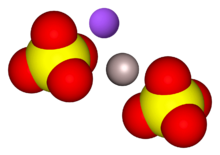شبة الصوديوم

| |
| الأسماء | |
|---|---|
| اسم أيوپاك
Aluminium sodium bis(sulfate) — water (1:12)
| |
| أسماء أخرى | |
| المُعرِّفات | |
| رقم CAS | |
3D model (JSmol)
|
|
| ChemSpider | |
| ECHA InfoCard | 100.030.239 |
| رقم EC |
|
| E number | E521 (acidity regulators, ...) |
PubChem CID
|
|
| UNII |
|
CompTox Dashboard (EPA)
|
|
| |
| |
| الخصائص | |
| الصيغة الجزيئية | NaAl(SO4)2·12H2O |
| كتلة مولية | 458.28 g/mol |
| المظهر | white crystalline powder |
| الكثافة | 1.6754 (20 °C) |
| نقطة الانصهار | |
| قابلية الذوبان في الماء | 208 g/100 ml (15 °C) |
| معامل الانكسار (nD) | 1.4388 |
| البنية | |
| البنية البلورية | Cubic, cP96 |
| الزمرة الفراغية | Pa3, No. 205 |
| ثابت العقد | a = 1221.4 pm |
| هندسة إحداثية |
Octahedral (Na+) Octahedral (Al3+) |
| المخاطر | |
| نقطة الوميض | غير قابل للاشتعال |
| مركبات ذا علاقة | |
كاتيونات أخرى
|
شبة الأمونيوم شبة البوتاسيوم |
ما لم يُذكر غير ذلك، البيانات المعطاة للمواد في حالاتهم العيارية (عند 25 °س [77 °ف]، 100 kPa). | |
| مراجع الجدول | |
شبـّة الصوديوم أو كبريتات الصوديوم ألومنيوم هي مركب كيميائي له الصيغة الكيميائية NaAl(SO4)2·12H2O (ويُكتب أحياناً Na2SO4·Al2(SO4)3·24H2O). هذه المادة الصلبة البيضاء تستخدم في صناعة مسحوق الخبيز وكـمضاف غذائي.
اسمها المعدني الرسمي هو alum-Na (رمز IMA هو: Aum-Na[1]).
. . . . . . . . . . . . . . . . . . . . . . . . . . . . . . . . . . . . . . . . . . . . . . . . . . . . . . . . . . . . . . . . . . . . . . . . . . . . . . . . . . . . . . . . . . . . . . . . . . . . . . . . . . . . . . . . . . . . . . . . . . . . . . . . . . . . . . . . . . . . . . . . . . . . . . . . . . . . . . . . . . . . . . . .
الخصائص
مثل نظيره للبوتاسيوم، فإن شبة الصوديوم تتبلور كـهيدرات اثناعشرية في بنية ألومنيوم مكعبة كلاسيكية.
Sodium alum is very soluble in water, and is extremely difficult to purify. In the preparation of this salt, it is preferable to mix the component solutions in the cold, and to evaporate them عند درجة حرارة لا تتجاوز 60 °س. 100 جزء من الماء يذيب 110 جزء من شبة الصوديوم عند 0 °س، و 51 جزء عند 16 °س.
الانتاج والتواجد الطبيعي
شبة الصوديوم (كبريتات الصوديوم ألومنيو) تنتج من جمع كبريتات الصوديوم و كبريتات الألومنيوم. نحو 3000 طن/سنة يُنتج حول العالم (2003).
The dodecahydrate is known in mineralogy as alum-(Na).[2][3] Two other rare mineral forms are known: mendozite (undecahydrate)[4] and tamarugite (hexahydrate).[5]
الاستخدامات
In the US, some brands combine sodium aluminum sulfate with sodium bicarbonate and monocalcium phosphate in formulations of double acting baking powder.[6] Kawahara et al 1994 noted that aluminum is “a suspected risk factor in Alzheimer's disease” and that “aluminum directly influences the process of Alzheimer′s disease”.[7]
كما تُستخدم شبة الصوديوم كـ منظم حموضة في الطعام، مع رقم E E521.
Sodium alum is also a common mordant for the preparation of hematoxylin solutions for staining cell nuclei in histopathology.[بحاجة لمصدر]
It is also used as a flocculant in water treatment and disinfection, but its relatively crude, caustic action makes it more suitable for industrial applications.[8]
انظر أيضاً
المراجع
- ^ Warr, L.N. (2021). "IMA-CNMNC approved mineral symbols". Mineralogical Magazine. 85 (3): 291–320. Bibcode:2021MinM...85..291W. doi:10.1180/mgm.2021.43. S2CID 235729616.
- ^ Burke, Ernst A.J. (2008). "Tidying up mineral names: an IMA-CNMNC scheme for suffixes, hyphens and diacritical marks" (PDF). Mineralogical Record. 39 (2): 131–35. CiteSeerX 10.1.1.1059.475. قالب:GALE ProQuest 211734059.
- ^ قالب:WebMineral.قالب:Mindat.
- ^ قالب:WebMineral.قالب:Mindat.
- ^ قالب:WebMineral.قالب:Mindat.
- ^ Helmboldt, Otto; Keith Hudson, L.; Misra, Chanakya; Wefers, Karl; Heck, Wolfgang; Stark, Hans; Danner, Max; Rösch, Norbert. "Aluminum Compounds, Inorganic". Ullmann's Encyclopedia of Industrial Chemistry. Weinheim: Wiley-VCH. doi:10.1002/14356007.a01_527.pub2.
{{cite encyclopedia}}: Cite has empty unknown parameter:|authors=(help) - ^ Kawahara, M.; Muramoto, K.; Kobayashi, K.; Mori, H.; Kuroda, Y. (January 1994). "Aluminum Promotes the Aggregation of Alzheimer′s Amyloid β-Protein in Vitro". Biochemical and Biophysical Research Communications. 198 (2): 531–535. doi:10.1006/bbrc.1994.1078. PMID 7507666.
- ^ "Products of the Sodium Hydroxide Tree" (PDF). WorldChlorine.org. Retrieved 17 June 2019.